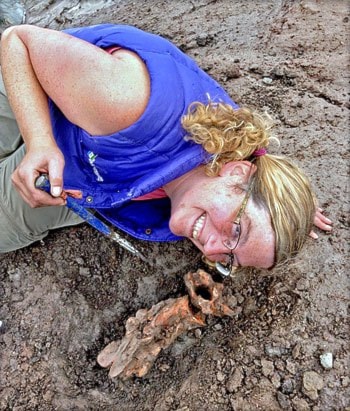For the third straight year, two paleontology field assistants - Elizabeth Hall and Susan Hewiston - have been combing the Klondike gold fields, looking for bones belonging to beasts that roamed the Yukon thousands of years ago.
The duo is part of the Yukon Paleontology Program, which works closely with miners in the area to unearth fossils that will ultimately be added to a growing collection.
The program has been around since 1995, but it was a one-man show until 2011, with Grant Zazula, head of the program, and his predecessors going up to Dawson every summer on their own.
Having people on the ground means more specimens are discovered each summer, including more rare bones.
Some of the miners stick to an old-fashioned mining technique called hydraulicking, which involves the use of a high-pressure water nozzle called a hydro monitor to dislodge the thick sludge between them and gold deposits.
It’s a slow but cheap method that has been around since the California Gold Rush.
For paleontologists, it’s a boon to their work. The process frees up bones and keeps them intact.
“It’s a good symbiotic relationship,” said Zazula.
This summer, Hall and Hewiston have uncovered a number of bones from carnivores, which they don’t usually find.
Bear, wolf, fox and ice-age lion bones are among the rare finds.
On a typical day, the pair drives around the various claim sites and picks the ones they want to explore.
“We’ve established relationships with a lot of the miners,” Hall said.
“If they’re previously found bones they’ll set them aside for us. Then we will walk around the site and look at the various layers, which can give us information on the age of the bones.”
Zazula said the program has collected thousands of bison, horse and mammoth bones over the years, but it only has a handful of lion and camel bones in its collection.
“Having people on the ground in Dawson means the quantity of stuff is just incredible,” he said.
“Because of the quantities we’re also getting more of the rare stuff. Now we can start doing research on some of these species.”
Hall and Hewiston work for 10-day shifts, then bring their finds down to Whitehorse.
They’ll be going back and forth until the end of September, which is when the team will start unpacking boxes, washing bones and identifying them.
After they’ve done that, they catalogue them and put them into the database.
When Zazula started in 2006, there were approximately 5,000 bones in the database. Now it’s closer to 25,000.
One of the more rare discoveries was that of a rare ice age horse skull found at Canyon Creek in July.
“The collection is expanding quickly and becoming more scientifically important,” Zazula said, adding that they work closely with geologists and other experts to determine what life and the climate was like during the ice age here.
The Yukon Arts Centre is hosting a new exhibit from September 4 to November 29, featuring dozens of ice age fossils, casts and specimens.
Ninety per cent of the specimens are from the Yukon.
The exhibit will also feature a herd of caribou in the form of over 200 wall tiles from Tagish-based sculptor Sandra Grace Storey.
Contact Myles Dolphin
at myles@yukon-news.com
